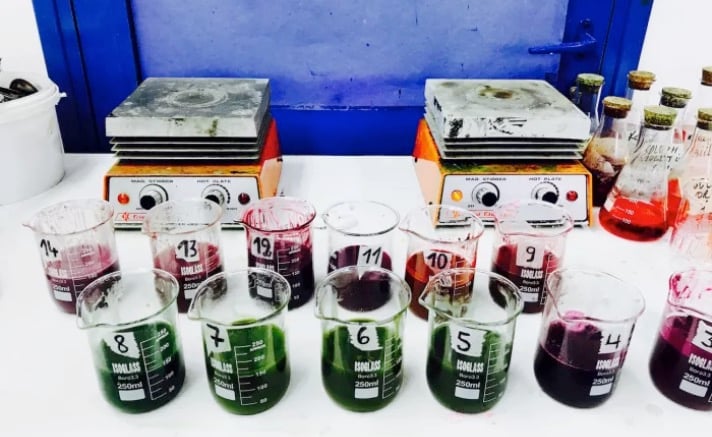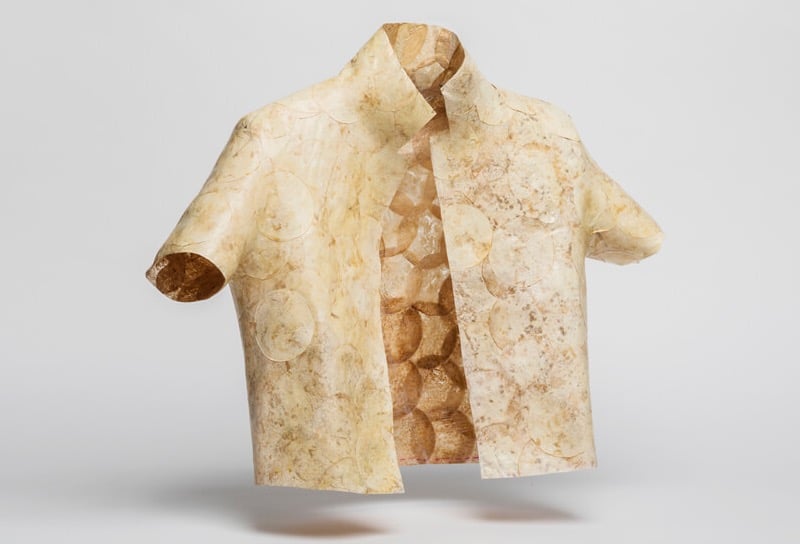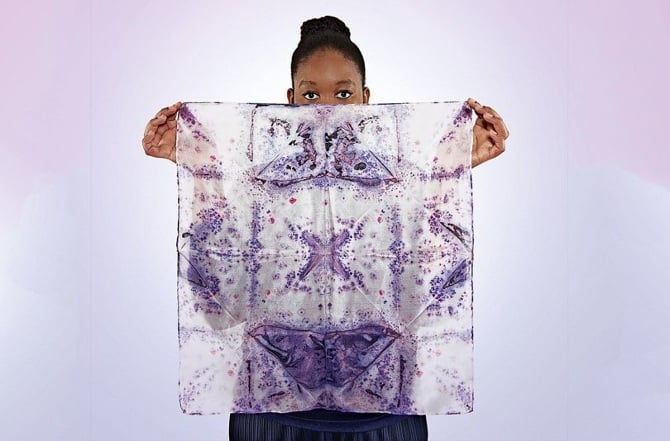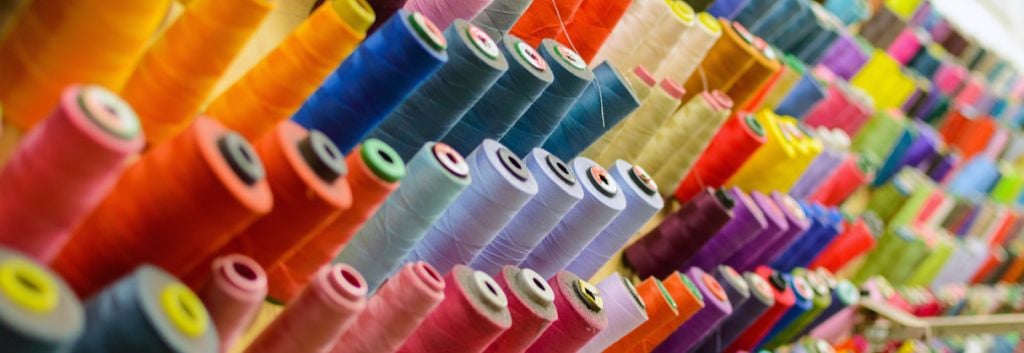Newsletter Signup - Under Article / In Page
"*" indicates required fields
The fashion industry is seeing the beginnings of a biotechnological revolution: using biology to make clothing to make textiles better and more sustainable.
Biotechnology already plays an important role in the textile industry. Enzymes are used routinely to wash and bleach textiles, to give jeans a denim look or to prevent wool from shrinking. A new wave of technology could take this a step further. In a not-so-distant future, our clothes will be made and dyed by living microbes, ditching many of the chemical processes that make fashion one of the most polluting industries in the world.
Many players around the world are already disrupting the fashion industry with biofabrication. I talked to four companies in Europe leading the biological revolution in the fashion industry to find out more about how their technology is changing the way we make clothes.
Growing spider silk with bacteria
Spider silk is known for being a strong, flexible and lightweight material, but it is not possible to farm spiders at an industrial scale. Based in Germany, AMSilk uses genetically engineered bacteria to get around that problem. Inside fermentation bioreactors, the bacteria produce spider silk protein, which is then spun into fibers, creating a brand new material with unique properties.
“In textiles, we haven’t seen a truly new material in decades,” CEO Jens Klein told me. AMSilk just celebrated the launch of the first product made with this spider silk — a luxury watch strap. The company is working in several other products using the spider silk fibers, including biodegradable sneakers for Adidas.

“In terms of design, you can tune the material properties from a molecular level, granting you significantly more control over the final product than is possible with traditional materials,” said Klein. From a sustainability perspective, the material doesn’t need any animal or petroleum input.
“The fashion industry, like many others, is struggling to satisfy competing demands for performance and sustainability,” explained Klein. “On the one hand, consumers want products with better performance properties, and on the other, they are demanding more sustainable materials and production methods. Traditional materials cannot meet both demands, but biofabricated materials can.”
Nurturing the body with algae
Not only is the fashion industry responsible for 20% of water pollution in the world. The chemicals used to make and dye fabrics are often toxic, harming and killing thousands of workers. These chemicals can also leach to the skin of the wearer.
Seaweed could be the solution. The German-Israeli firm Algalife is growing fibers and dyes using algae. “We are using a closed loop system with zero waste, we don’t need anything to grow it besides sunlight and water,” said CEO Renana Krebs.

After 15 years working in the fashion industry, Krebs decided it was time to lead a much-needed change. The clothes made at Algalife are not just more sustainable in terms of pollution, land, water, and energy use. They are also designed to nurture the skin of the wearer with the natural compounds produced by seaweed. “You really have a wellness product that is allergen-free, chemical-free, pesticide-free, and nourishing for the skin,” Krebs told me.
Algalife aims to reach mass production this year, with the first products focused on home and sportswear. In the future, Krebs envisions being able to customize the specific compounds produced by algae, such as proteins or vitamins. “It’s a win-win solution for all stakeholders: manufacturers, workers, and customers.”
Growing clothes from fungi
“Factories are closing due to environmental issues, plastic pollution is a big problem and there is only so much land we can use for cotton growth, instead of food. The fashion industry needs to change and is looking for new innovations,” said Aniela Hoitink, founder of the Dutch firm NEFFA.
Hoitink has created a fabric that is grown out of mycelia — the roots of mushrooms. The fungi are grown in discs that are then stuck together to create custom clothes without seams. “As we skip steps of spinning yarn, weaving cloth, cutting patterns, and sewing garments, we are not only reducing waste throughout the production phase, but also resources like water, farmland, and transport,” Hoitink told me.

The material also leaves no waste behind. “After wearing, you can simply bury the garment in the ground and it will decompose,” said Hoitink.
NEFFA has already created several prototypes of dresses, jackets and purses created using this method. “Technologies to fabricate textiles need an huge update,” said Hoitink. “A tree has a new set of leaves every year. Nature has its own consumptive behaviour and yet it manages to keep the planet healthy. What can we learn from that? Biomimicry and biology should play a bigger role in our future.”
Dyeing clothes with bacteria
The dyeing industry makes a huge environmental impact in terms of water use and water pollution. In the UK, the firm Faber Futures is developing an alternative dyeing method through fermentation, using bacteria such as Streptomyces coelicolor.
“Water is reduced massively and we don’t need to use any chemicals because the dye is deployed directly onto the textile,” said Natsai Audrey Chieza, founder and Director of Faber Futures. In early tests, her technology has proven to use 500 times less water than conventional dyeing. “In many aspects this is a revolution in textile dyeing.”

Faber Futures is developing colorfast dyes that don’t fade with time or washing. In the future, biology could unlock new possibilities for dyeing, such as adaptive colors. “Beyond sustainability, we are talking about new capabilities and new features beyond our one-dimensional way of thinking about dye,” Chieza told me.
Chieza is now working with several brands to develop together the best strategies to incorporate this dyeing technology to their individual needs. She expects to have the first products launched in the next couple of years.
“We are looking at different approaches to fermentation and extracting pigments to achieve various finishes,” said Chieza. “We are looking at it from a holistic, systemic approach to explore how to design with biology.”
The future of fashion
There is still a lot of work needed until biofabrication becomes mainstream in the fashion industry and replaces traditional methods to produce and dye fabric. One of the big challenges is transforming prototype biological processes into industrial-scale production, which will be key to make these products widely available and affordable.
“With any fundamentally new material, the price point will initially be above common materials, both to reflect the impact of the innovation and to take account of the material’s value,” said Klein. “As the industry begins to scale up, and as you see companies begin to produce these biofabricated materials at commercial scale, we will begin seeing them approach the broader market.”
Another challenge is to determine the real impact that these new processes actually have on the environment. “What needs to be measured, and nobody has done this yet because scale-up is still in progress, is a full life cycle analysis,” said Chieza. “We have to remember that fermentation is tied to carbon, which currently comes from sugar. We have to look at sustainability in terms of the input.”
As biofabrication keeps advancing and scaling up, the fashion industry is poised to change radically. “Fashion will need to become more comfortable with longer R&D cycles and perhaps somewhat slower consumption. The fashion industry is very much powered to produce and discard, and that model is broken,” added Chieza.
“We want a fashion industry that is clean, healthy and sustainable, for the workers and for the end users,” said Krebs. “We are the green engine for the fashion revolution.”
It will take time. After all, it took decades since nylon was developed in the 1930s until it became as ubiquitous as it is today. But the future of fashion is already here, and biology is the future.
Images via AMSilk, Algalife, NEFFA, and Faber Futures
Partnering 2030: FME Industries Report







